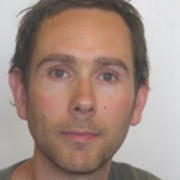
Marc Chesterman
Marc Chesterman’s love affair with the possibilities of sound has manifested in all kinds of locations: behind the drum kit and mixing desk, on film sets, and in an aeroplane headed for Venice.
Apart from a year learning drums at Whitireia Polytechnic, and the occasional guitar lesson, Marc Chesterman has largely learnt about sound from experience. He began drumming with alternative rock trio Lushburger in the early 90s, then played with experimental rockers Sudersuk, including on their 1996 CD Feather. He gained further production experience as a longtime member of electronic improvisers Audible 3.
In the mid 90s Chesterman began dabbling in theatre as a sound technician and designer, spurring an interest in soundtrack work which soon crossed over into film. He would go on to handle sound design and live sound mixes for dance group Mau on a number of international performances, including in Venice and New York City.
Chesterman did the music and sound mix for his first short, David Hatcher’s I/n F/inity, back in 1993. A few years later, while working as an AV technician at Auckland’s Elam School of Fine Arts, he met student Florian Habicht. Habicht had seen Sudersuk in concert, and went on to use some of Chesterman’s music in his early short films, including 1997's Liebesträume, and an hour long feature called Liebesträume - The Absurd Dreams of Killer Ray (1999).
The offbeat feel and deliberately unsynchronised sound of Liebesträume signalled a director with little interest in taking the traditional path. Chesterman supervised sound on both Liebesträumes, from composing the music to handling the sound design and mix. The same was true on Habicht’s breakthrough feature Woodenhead, in which the music was even more front and centre.
Woodenhead was promoted as a “Grimm musical fairy tale”, and the filmmakers literally put sound first. Dialogue and music — including all the songs — were all recorded before the actors filmed their scenes. Sometimes image and sound unfurled in synch, like a music video. At other times the two elements “work against each other”, or as Chesterman puts it, there might be “space between image and sound for an audience to interpret their own feeling”.
Woodenhead was nominated in the digital section of the NZ Film and TV Awards, and screened at a number of overseas festivals. The soundtrack won praise from Sunday Star-Times music reviewer Grant Smithies. He described the eclectic mixture of lullaby, keyboards, cello and screaming guitar as “dark and quirky, part vaudeville, part fairy tale”.
Chesterman went on to handle composition and share the sound design on Habicht’s acclaimed follow-up Kaikohe Demolition. He also composed the original music used in Habicht’s 2008 Warwick Broadhead part-documentary Rubbings from a Live Man, and was sole composer for 2009's fishing tale Land of the Long White Cloud.
In a 2008 interview with Radio New Zealand, Chesterman said he composed "pretty sparse" music for Rubbings from a Live Man, as he didn't want to oversaturate the emotion coming off the screen. Habicht said in the same interview: "Marc's music is very beautiful and really moving — there's a few scenes where I get teary eyes."
Chesterman has also been responsible for finding an eclectic range of source music for many of Habicht’s films, a role he loves. Music editing has always been a shared role between himself, Habicht and editors Chris Pryor and Peter O’Donoghue. 2011 feature Love Story is dominated by some of the film composers that have long inspired Habicht, including Italians Nino Rota and Ennio Morricone. Says Chesterman: “The tracks are not overly emotive, they don’t tell you to feel a particular way — they’re more about momentum and providing energy and drive.”
Composing music for Habicht's Spookers (2017) provided a unique challenge. The documentary is based on a live horror attraction, and the people who work there. As Chesterman told RNZ, "Florian knew he was having all these characters on the bed and a lot of them were going to be snoring, so he says to me ‘Marc, [you need to] make some snoring music. So I was kind of like, how am I going to make snoring music? What even is snoring music?"
Chesterman sampled and manipulated recordings of the characters snoring. "...we were able to fashion their snoring sounds into a little narrative of sorts, and underlay that with a dreamy soft heartbeat type rhythm. It’s a nice gentle way to end things and it’s probably one of my favourite pieces in the film.”
Chesterman also composed the music for Bombay-born Kiwi Zia Mandviwalla’s immigration tale Eating Sausage, handled sound and music for dance film Blue Smoke, and was sound designer for Gaylene Preston’s Rita Angus documentary Lovely Rita.
Based in Wellington, Chesterman balances sound and music projects with his work as a studio operator for Radio New Zealand, and helping capture sports coverage for Sky Television.
Updated on 10 January 2020
Sources include
Marc Chesterman
Marc Chesterman website. Accessed 10 January 2020
'Florian Habicht and Marc Chesterman' (Radio Interview) Radio New Zealand. Loaded 18 July 2008. Accessed 10 January 2020
'Music for zombie brides and killer clowns' (Radio Interview) Radio New Zealand. Loaded 11 August 2017. Accessed 10 January 2020
Florian Habicht website. Accessed 10 January 2020